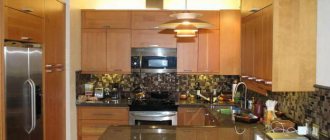Definition, concept and classification of residential and non-residential real estate: what is it?
One of the main concepts in this area is the definition of “real estate”. Part 1 art. 130 of the Civil Code of the Russian Federation classifies as real estate land plots, subsoil plots and everything that is inextricably linked with the land, that is, objects whose movement without damage to them is not possible. This standard includes buildings, structures, and unfinished construction projects.
The exact definition of the concepts “building” and “structure” is established by the Federal Law “Technical Regulations on the Safety of Buildings and Structures” dated December 30, 2009 No. 384-FZ.
- A building is the result of construction, which is a volumetric system with above-ground and (or) underground parts, including premises, engineering support networks and engineering support systems for living and (or) activities of people, production location, product storage , says sub. 6 paragraph 2 art. 2 of the above Regulations.
- A structure is a result of construction, which is a volumetric, planar or linear construction system, having ground, above-ground and (or) underground parts, consisting of load-bearing and enclosing building structures, for performing various production processes, storing products, moving people and goods, it is said in sub. 23 clause 2 art. 2 Regulations.
The concept of the term “structure” remains open. Analyzing the entire regulatory framework governing the interaction of these terms “building” and “structure”, the term “structure” can be characterized as follows:
- A structure is any structure made by construction, inextricably linked to the earth's surface.
- A room is a part of the volume of a building or structure that has a specific purpose and is limited by building structures, in accordance with subclause. 14 paragraph 2 art. 2 Regulations.
All objects of this type of real estate can be classified on several grounds (Table No. 1).
Table No. 1:
| By type of ownership | By industry | According to the degree of readiness for operation | By purpose |
| Private | Industrial | Put into operation | Residential |
| State | Construction | Construction in progress | Commercial |
| Collective | Cultural and everyday life | Requiring reconstruction | Municipal |
| Public organizations | Housing and communal services | Not put into operation | Special |
Objects of this type of real estate also have a number of certain characteristics (Table No. 2).
Table No. 2:
| Signs of residential premises | Signs of non-residential premises |
| Suitable for permanent residence, meets all sanitary and technical standards. | Unsuitable for permanent residence, does not meet sanitary and technical standards for residence. |
| Has the communications necessary for living. | Communications are partially carried out or absent. |
| Used only for residential purposes. | Can be used for commercial purposes. |
| Availability of registered citizens. | There are no registered citizens. |
| Included in the housing stock. | Included in the non-residential fund. |
Common features for both types of premises:
- They are real estate.
- An inextricable connection with the land plot on which they are located.
- Isolation.
- Durability.
- Uniqueness.
- Variety.
- Materiality.
- Cost form.
- Inability to move in space.
Individual residential building
The definition of an individual residential building is given in the Town Planning Code. An individual residential building is understood as a separate residential building with no more than three floors, intended for one family.
Thus, the definition of an individual residential building includes three criteria:
- isolation;
- appointment;
- number of floors;
Let's look at each of these parameters.
Isolation
According to this criterion, the house is characterized as detached. Thus, an individual residential building differs from blocked houses, on the one hand, and multi-level apartments in multi-apartment buildings, on the other hand.
An individual residential building differs from these houses in that all the load-bearing structures are its own and are intended only for this house: the house stands on its own foundation, intended specifically for it, and has its own walls, that is, those that are not the walls of another house.
Purpose
An individual residential building is distinguished by the fact that it is, firstly, residential, and secondly, individual, that is, intended for one family.
1. In accordance with the Housing Code, a residential building is a building consisting of residential and auxiliary premises that are intended to satisfy household and other needs associated with living in such a building.
The main difference between a residential building and other buildings is that people live in it permanently or temporarily. At the same time, such vital processes as sleep, rest, eating, cooking, personal hygiene and toilet, storing food and things, caring for things, operating the engineering systems of the house, work/hobbies take place in the house.
2. A family in the legal sense is usually understood as an association of persons who are bound by mutual rights and obligations arising from marriage, kinship, adoption or adoption into the family. This is one of the general doctrinal definitions of family (the concept of family is not fixed in law), but it is not the only one and provides quite a lot of scope for expanding the circle of persons who may fall under the concept of “one family.”
Number of floors
The criterion for the number of floors is perhaps the most controversial.
An individual residential building can be recognized as such if it has no more than three floors. Let us say right away that these floors include all floors, including the attic and basement.
On the Internet you can find a lot of information that the basement floor, under certain circumstances, may not be considered a floor for determining the number of storeys of a house. This is indeed true, but only for the purposes of cadastral registration, as well as housing accounting.
According to the Letter of Rosnedvizhimost dated 08/27/2008 No. AM/1567 “On the number of storeys of a residential building” and the Instructions on the accounting of housing stock in the Russian Federation, approved by Order of the Ministry of Land Construction of the Russian Federation dated 08/04/1998 No. 37 (as amended on 09/04/2000 .) the number of storeys of a residential building is determined by the number of above-ground floors. The basement floor is considered above ground and is taken into account when determining the number of storeys of a house if the top of its floor is at least 2 meters above the average planning level of the ground.
According to modern practice, the distance from the ground to the top of the basement floor is usually less than 2 meters and even less than 1.5 meters, so the basement floor in most cases is not included in the number of above-ground floors, and, therefore, from the point of view of cadastral registration and accounting of the housing stock, not taken into account when calculating the number of storeys of a house.
However, paragraph 1 of part 2 of Article 49 of the Town Planning Code (as well as other articles of the Town Planning Code, which define an individual residential building and individual housing construction) does not indicate that the three floors of an individual residential building include only above-ground floors.
Therefore, excluding underground floors from the number of floors of an individual residential building for the purpose of determining whether the house is individual residential or not would not be consistent with the Town Planning Code.
Therefore, excluding underground floors from the number of floors of an individual residential building for the purpose of determining whether the house is individual residential or not would not be consistent with the Town Planning Code.
In addition, paragraph 4.7 of SP 55.13330.2011 “Single-apartment residential buildings” (updated edition of SNiP 31-02-2001) states that the rules for calculating the area of premises, determining the volume and number of storeys of a house and the number of floors are adopted according to SP 54.13330 (“Residential multi-apartment buildings ", updated version of SNiP 31-01-2003).
In paragraph B.1.6 of Appendix B (Rules for determining the area of a building and its premises, building area, number of storeys and building volume) of the said regulatory document there are no discrepancies with the Town Planning Code and it is stipulated that when determining the number of floors, all floors are taken into account, including underground, basement, basement, above-ground, technical, attic and others.
The judicial practice of applying the above norms of the Town Planning Code also confirms the illegality of excluding the basement floor as an underground floor from the number of floors of an individual residential building.
Thus, a two-story house with an attic and a basement will already have four floors, which means that, according to the criterion of the number of floors, it will not be an individual residential building. By building such a house, the developer will violate the intended purpose of the land plot, if the plot was provided for individual housing construction.
Is it possible to change the purpose of the house?
According to paragraph 2 of Art. 671 and paragraph 3 of Art. 288 of the Civil Code of the Russian Federation, residential premises are intended only for the residence of citizens, and their use for other purposes (for example, as an office) is allowed only after the latter are transferred to the status of “non-residential” in compliance with a certain procedure. However, there are exceptions here.
It is worth saying that clause 2 of Art. 17 of the Housing Code of the Russian Federation is still allowed to use residential premises in business activities, provided that this does not violate the rights of other residents and also meets all necessary requirements.
Thus, the lawyer, on the basis of paragraphs 6, 7 of Art. 21 of Federal Law No. 63-FZ “On Advocacy and the Bar in the Russian Federation” may use residential premises that are his property or owned by members of his family to provide his services.
However, this is an isolated case. Arbitration practice generally prohibits the use of residential premises for purposes other than their intended purpose. Thus, the law almost completely excludes cases when a residential building may have a non-residential purpose.
Conversion of a garden house into a residential building
The procedure for recognizing a garden house as a residential building is regulated by Decree of the Government of the Russian Federation dated January 28, 2006 No. 47 “On approval of the Regulations on the recognition of premises as residential premises...” (as amended on December 24, 2018) (hereinafter referred to as the Regulations).
Requirements for a residential building:
According to Art. 15 Housing Code of the Russian Federation, Art. 4 of the Regulations, residential premises are recognized as isolated premises, which are intended for the residence of citizens, are real estate and are suitable for living, meeting established sanitary and technical rules and regulations, and other legal requirements.
In other words, a residential building must:
- To be built on a foundation, i.e. have a strong connection with the earth;
- Be safe for the life and health of residents;
- Have electricity;
- Be provided with water supply;
- Have a sewerage system (septic tank);
- Be provided with heat supply.
Required documents:
- Application for recognition of a garden house as a residential building.
The application is written in free form with the obligatory indication of the following information:
- Full name of the applicant;
- Postal or email address of the applicant;
- Cadastral number of the land plot;
- Cadastral number of the garden house.
- Method of obtaining a decision from a local government body (in person, by mail, at the MFC).
Sample application:
- Extract from the USRN for a garden house. If the garden house is not registered, then the title document for the house (sale and purchase agreement, certificate of inheritance, etc.). Providing an extract is not mandatory.
- Conclusion on the inspection of the technical condition of the object. This document is the basis for making a decision on converting a garden house into a residential one. The conclusion is prepared by a specialized organization or individual entrepreneur that is a member of the SRO in the field of engineering surveys. An example of such a conclusion:
- If the garden house is under mortgage, then the notarized consent of the mortgagee (bank) to re-register the house is required.
Submission of documents to the Administration.
Documents are submitted in person to the Administration or through the MFC. In response, the Administration or MFC specialist issues the applicant a receipt for receipt of documents.
The application review period is 45 calendar days.
Upon expiration of the specified period, the Administration makes one of two decisions:
- on recognition of a garden house as a residential building;
- on refusal to recognize a garden house as a residential building.
In case of refusal, the Administration is obliged to refer in its decision to one of the following grounds for refusal:
- The application does not contain mandatory information (postal address, cadastral numbers);
- There is no conclusion on the inspection of the object;
- The applicant is not the owner of the garden house;
- The Unified State Register of Real Estate does not contain information about rights to a garden house;
- The consent of the mortgagee (bank) has not been submitted;
- The types of permitted use of the land do not include the placement of a house.
An applicant who does not agree with the decision to refuse has the right to appeal it in court within 3 months.
What premises cannot be used as housing stock?
From the point of view of the law, the emergence of the legal status of residential premises in a non-residential building is excluded. According to the legal definition of the term “residential premises,” one of its immediate features is the presence of registered citizens living in its area. Non-residential real estate, on the contrary, cannot be legally recognized as a place of residence. Therefore, it is legally impossible to register there. This will be the main difference between non-residential and residential buildings.
This rule was established by Decree of the Government of the Russian Federation dated July 17, 1995 No. 713. However, if a citizen arbitrarily occupied non-residential premises belonging to him by right of ownership for the purpose of living, no one has the right to evict him from there, however, in this case administrative liability may be imposed for lack of registration . To date, the law does not provide for the status of residential premises in a non-residential building.
Building signs
Based on the definition of the concept of a building given in paragraph 6 of Part 2 of Art. 2 of the Technical Regulations, the following features can be distinguished:
- a building is created as a result of construction;
- the building is a volumetric building system (as opposed to planar and linear building systems);
- the building may have both above-ground and underground parts or both parts;
- the building necessarily includes premises. They are part of the volume of the building, have their own purpose and are limited by building structures;
- networks and engineering support systems must be located inside the building, for example, communications, pipelines that are designed to provide the building, and water supply, heating, ventilation, power supply, communications systems;
- the building must have a special purpose, that is, used: for human habitation (residential buildings) or human activity (the building can be intended simultaneously for human habitation and activity, for example, office space can be located on the ground floor of a residential building); to accommodate production (industrial buildings); for storing products (for example, warehouses); for keeping animals (for example, cowsheds, stables).
Is it acceptable to distinguish between the name of a structure and its use?
In practice, a situation is possible when part of the building has a non-residential purpose. Bars, shops, hairdressers and cafes located on the first and ground floors of houses have exclusively commercial purposes. Thus, they cannot have the status of “residential premises”.
Before starting the operation of the enterprise, the owner is obliged to carry out the procedure for transferring residential premises to non-residential premises.
According to the provisions of Art. 22 of the Housing Code of the Russian Federation, the presence of non-residential premises in a residential building is possible subject to the following conditions:
- if it has a separate gladdened entrance;
- it is not part of the residential premises;
- no one lives in it;
- there are no burdens on him.
also be necessary to organize a general meeting of owners, as well as obtain the support of residents of the apartments closest to the non-residential premises. This norm is established by federal law No. 116-FZ of May 29, 2021 “On Amendments to the Housing Code of the Russian Federation.”
The total number of votes “for changing the legal status of the premises” at the meeting must be more than half. The law allows the presence of non-residential premises in the housing stock, but subject to certain conditions.
Ownership of land and common property of an apartment building
Buying an apartment in a new building involves not only the transfer of ownership of the premises. This is also a number of features of owning parts of a land plot.
The land plot becomes the common shared property of apartment buyers after registration and cadastral registration.
This is important to know: How to register an unfinished non-residential building
Public premises, elements of improvement and functional support of the building belong to common shared ownership.
These parts of the property cannot be allocated in kind for alienation or other disposal, and separate rights are not issued for the land plot related to the apartment in the house.
The previous paragraph reveals the peculiarity of the right - ownership of the land under an apartment building is confirmed when purchasing an apartment, but cannot be realized in kind or by alienation.
All this matters; these features should be known, but they are not decisive when choosing an apartment or a new building. However, there are several features that you should be aware of in order to avoid becoming a victim of deception.
Difference between objects: how are the main characteristics different?
To make it easier to understand the differences, we present them in the form of a table (Table No. 3).
Table No. 3:
| Residential Properties | Non-residential real estate |
| Compliance with technical and sanitary standards for living (sufficient area, certain sanitary and hygienic conditions, noise, thermal standards, lighting and air exchange, technical and fire standards). | The necessary living conditions for citizens are partially or completely absent. |
| Availability of communications (sewage, ventilation, water supply, electricity, gas supply). | Communications are partially or completely absent. |
| Use for commercial purposes is possible only in exceptional cases (lawyer's office). | Commercial use permitted. |
| Possibility of registration of citizens. | Registration of citizens is prohibited. |
We examined the main features of the legal status of residential and non-residential real estate. A number of issues remain unresolved to this day, but legislation in the housing sector is one of the most progressive and continues to actively develop.







